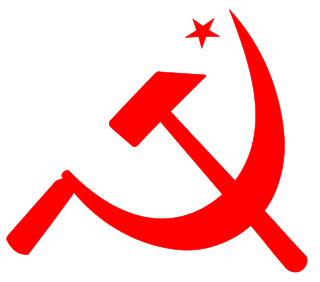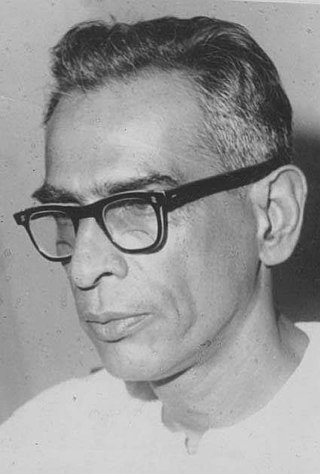Related Research Articles
Due to the ancient land relations and taxation and regulation under the British Raj, at the time of independence, India inherited a semi-feudal agrarian system, with ownership of land concentrated in the hands of a few individual landlords. Since independence, there has been voluntary and state initiated/mediated land reforms in several states. The most notable and successful example of land reforms are in the states of West Bengal and Kerala. The Land Reforms Ordinance was a law in the state of Kerala, India by K. R. Gowri Amma minister in the first EMS government.

The Communist Party of India (Marxist) (abbreviated as CPI(M)/CPIM/CPM) is a communist political party in India. It is the largest communist party in India in terms of membership and electoral seats, and one of the national parties of India. The party was founded through a splitting from CPI in 1964 and it quickly became the dominant fraction.

The Communist Party of India (CPI) is the oldest communist party in India. The CPI was founded in modern-day Kanpur on 26 December 1925. Currently it has 2 members in Lok Sabha and 2 members in Rajya Sabha. In addition, it has 22 MLAs across 4 states and 1 MLC in Bihar. It has the current ECI status of a state party in Tamil Nadu, Kerala and Manipur.

Jyoti Basu was an Indian Marxist theorist, communist activist, and politician. He was one of the most prominent leaders of Communist movement in India. He served as the 6th and longest serving Chief Minister of West Bengal from 1977 to 2000. He was one of the founding members of the Communist Party of India (Marxist). He was the member of Politburo of the party since its formation in 1964 till 2008. He was also the member of West Bengal Legislative Assembly 11 times. In his political career, spanning over seven decades, he was noted to have been the India's longest serving chief minister in an elected democracy, at the time of his resignation. He was proposed for the post of Prime Minister of India for four times.

Tebhaga movement (1946–1947) was significant peasant agitation, initiated in Bengal by the All India Kisan Sabha of peasant front of the Communist Party of India.

The Permanent Settlement, also known as the Permanent Settlement of Bengal, was an agreement between the East India Company and landlords of Bengal to fix revenues to be raised from land that had far-reaching consequences for both agricultural methods and productivity in the entire British Empire and the political realities of the Indian countryside. It was concluded in 1793 by the Company administration headed by Charles, Earl Cornwallis. It formed one part of a larger body of legislation, known as the Cornwallis Code. The Cornwallis Code of 1793 divided the East India Company's service personnel into three branches: revenue, judicial, and commercial. Revenues were collected by zamindars, native Indians who were treated as landowners. This division created an Indian landed class that supported British authority.

K. R. Gouri, born Kalathilparambil Raman Gouri, commonly known as Gouri Amma, was an Indian politician from Alappuzha in central Kerala. She was one of the most prominent leaders of the Left movement in India.
Operation Barga was a land reform movement, throughout rural West Bengal for recording the names of sharecroppers (bargadars) while avoiding the time-consuming method of recording through the settlement machinery. It bestowed on the bargadars, the legal protection against eviction by the landlords (jotedars), and entitled them to the due share of the produce. Operation Barga was launched in 1978 and concluded by the mid-1980s. Introduced in 1978, and given legal backing in 1979 and 1980, Operation Barga became a popular but controversial measure for land reforms. The ultimate aim of these land reforms was to facilitate the conversion of the state's bargadars into landowners, in line with the Directive Principles of State Policy of the Indian Constitution. To date, Op Barga has recorded the names of approximately 1.5 million bargadars. Since then, it has been marked as one of the most successful land reforms programs in India.
Badulia is a village in Khandaghosh CD Block in Bardhaman Sadar South subdivisionof the Purba Bardhaman district in the state of West Bengal in India.
M. N. Govindan Nair, popularly known as MN, was an Indian communist politician born in Pandalam, in Pathanamthitta district, India. He is known as "Kerala Khrushchev".
The Comprehensive Agrarian Reform Program, more commonly known as CARP, is an agrarian reform law of the Philippines whose legal basis is the Republic Act No. 6657, otherwise known as the Comprehensive Agrarian Reform Law (CARL). It is the redistribution of private and public agricultural lands to help the beneficiaries survive as small independent farmers, regardless of the “tenurial” arrangement. Its goals are to provide landowners equality in terms of income and opportunities, empower land owner beneficiaries to have equitable land ownership, enhance agricultural production and productivity, provide employment to more agricultural workers, and put an end to conflicts regarding land ownership.

Hare Krishna Konar was an Indian Marxist revolutionary, political theorist, charismatic peasant leader and politician. Konar was a founding member of the Communist Party of India (Marxist), the figurehead behind India's first land reform, and the chief architect of the West Bengal land distribution. Between the 1960s and 1970s, he became one of the principal leaders of the Communist movements in India. In 1932, due to his involvement in the Begut Robbery Case of the Jugantar Party, Konar was deported to the Cellular Jail of the Andaman for 6 years at the age of 18, there he took part in the first hunger strike and in 1935 he founded the Communist Consolidation and led the historical second hunger strike.

The Indian state of Kerala has a strong presence of communist politics. Today, the two largest communist parties in Kerala politics are the Communist Party of India (Marxist) and the Communist Party of India, which, together with other left-wing parties, form the ruling Left Democratic Front alliance.
Land acquisition is the power of the union or a state government in India to take private land for public, and to compensate the original owners and other persons affected due to such acquisition.
Agrarian reform and land reform have been a recurring theme of enormous consequence in world history. They are often highly political and have been achieved in many countries.
Land reform in the Philippines has long been a contentious issue rooted in the Philippines's Spanish Colonial Period. Some efforts began during the American Colonial Period with renewed efforts during the Commonwealth, following independence, during Martial Law and especially following the People Power Revolution in 1986. The current law, the Comprehensive Agrarian Reform Program, was passed following the revolution and extended until 2014.
Agrarian socialism is a political ideology that promotes social ownership of agrarian and agricultural production as opposed to private ownership. Agrarian socialism involves equally distributing agricultural land among collectivized peasant villages. Many agrarian socialist movements have tended to be rural, locally focused, and traditional. Governments and political parties seeking agrarian socialist policies have existed throughout the world, in regions including Europe, Asia, North America, Latin America, and Africa.

The Forty-seventh Amendment of the Constitution of India, officially known as The Constitution Act, 1984, amended the Ninth Schedule to the Constitution, and added 14 legislations relating to land reforms, enacted by the States of Assam, Bihar, Haryana, Tamil Nadu, Uttar Pradesh and West Bengal and the union territory of Goa, Daman and Diu with a view to provide that the enactments shall not be deemed to be void on the ground that they are inconsistent with any of the provisions of Part III of the Constitution relating to Fundamental Rights.
The Chengara struggle refers to an ongoing controversy about land near the Chengara village in the Pathanamthitta district in Kerala, India.

In 1964, a major split occurred in the Communist Party of India. The split was the culmination of decades of tensions and factional infighting. When India became independent in 1947, differences arose of how to adapt to the new situation. As relations between the Nehru government and the Soviet Union improved, a faction that sought cooperation with the dominant Indian National Congress emerged within CPI. This tendency was led by S.A. Dange, whose role in the party hierarchy became increasingly controversial. When the Sino-Indian War broke out in 1962 Dange's opponents within CPI were jailed, but when they were released they sought to challenge his leadership. In 1964 the party was finally divided into two, with the left faction forming the Communist Party of India (Marxist). The split had a lot of regional variations. It also impacted other organizations, such as trade union and peasant movements. The split has been studied extensively by scholars, who have sought to analyze the various domestic and international factors involved.
References
- ↑ Thorner, Daniel. 1976. Agrarian Prospect in India. New Delhi: Allied Publishers.
- ↑ Appu, P. S. 1996. Land Reforms in India: A Survey of Policy, Legislation and Implementation. New Delhi: Vikas Publishing House.
- 1 2 Besley, Timothy and Burgess, Robin. 2000. “Land Reform, Poverty Reduction, and Growth: Evidence from India.” The Quarterly Journal of Economics 115: 389-430.
- ↑ Appu, P. S. (1996). Land Reforms in India: A Survey of Policy, Legislation and Implementation. New Delhi: Vikas Publishing House.
- ↑ Deininger, Klaus. 2003. Land Policies for Growth and Poverty Reduction. Washington, DC: World Bank.
- 1 2 Basu, Kaushik, eds. 2008. The Oxford Companion to Economics in India. New Delhi: Oxford University Press.
- ↑ Dey Biswas, Sattwick. 2014. Land Rights Formalization in India; Examining de Soto through the lens of Rawls theory of justice. FLOOR Working paper 18. p. 16.
- ↑ "Assembly election 2011 West Bengal: Trinamool Congress rises like phoenix". The Times Of India.
- ↑ [Heller, Patrick. 1999. The Labor of Development. Ithaca: Cornell University Press, Chapters 2 and 3.]
- ↑ Banerjee, Abhijit V., Paul J. Gertler, and Maitreesh Ghatak. 2002. “Empowerment and Efficiency: Tenancy Reform in West Bengal.” Journal of Political Economy 2: 239–280.
- ↑ Roy, Dayabati. 2013. Rural Politics in India: Political Stratification and Governance in West Bengal. Cambridge University Press.
- ↑ Dey Biswas, Sattwick. 2014. Land Rights Formalization in India; Examining de Soto through the lens of Rawls theory of justice. FLOOR Working paper 18. pp 14-28
- ↑ Rezazadeh, Farhad (1979). Agricultural development in Iran: evaluation of state planning and policies in relation to agriculture (Thesis). Iowa State University. p. 15.
- ↑ Mathew, K M. "The land ceiling provisions under the Kerala Reforms Act". Kerala Law .com. Retrieved 20 October 2015.
- ↑ "Land Reforms". Commissionerate of Land Reforms. Government of Tamil Nadu. Retrieved 20 October 2015.
- ↑ "Bengal govt amends Land Reforms Act". The Indian Express. November 20, 2014. Retrieved 21 October 2015.